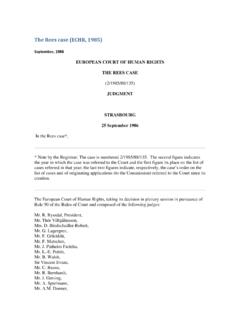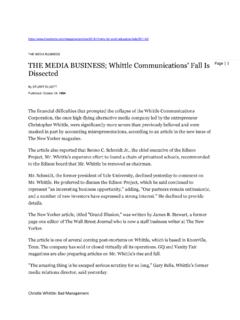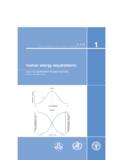Transcription of Engendered Penalties: Transgender and Transsexual People’s ...
1 Engendered Penalties: Transgender and TranssexualPeople s Experiences ofInequality and DiscriminationAuthors: Stephen whittle , Lewis Turner and Maryam Al-AlamiContributors: Em Rundall and Ben ThomTo enquire about alternative formats please contact telephone 0870 1226 report is available online from Crown Copyright 2007 Copyright in the typographical arrangement rests with the publication, excluding logos, may be reproduced free of charge in any format or medium forresearch, private study or for internal circulation within an organisation. This is subject to it beingreproduced accurately and not used in a misleading context.
2 The material must be acknowledgedas Crown copyright and the title of the publication other use of the contents of this publication would require a copyright licence. Please applyfor a Click-Use Licence for core material at by writing to the Office of Public Sector Information, Information Policy Team, St ClementsHouse, 2-16 Colegate, Norwich NR3 1BQ. Fax: 01603 723000 or e-mail: Product Code XX XXX XXXXXF ebruary 2007A Research Project and Report Commissioned by the Equalities ReviewThe views expressed in this report are those of the authors, not necessarily those of theEqualities 1 How many Trans People are there?
3 Experiencing Recent Developments in the Trans Trans People Seeking Equality InEqualities InAction: The case of the Prison Service The Future of Trans Equality and Non-Discrimination13 Chapter 2:Executive Summary Trigger Sectors and Spheres of The Changing Confidence in the Safety in Public Goods, Services and The School In the Home and Recommendations18 Chapter 3:Background to the Other Recent Research on Inequalities and Defining Inequalities and Discrimination21 Chapter 4:Findings A Tale of Ordinary The Where and When of Great Expectations: the Online Survey Response26 Chapter 5:Not fit to be seen in Public: Work, Papers, Health and Social Life Workplace Problems at Changing Accessing Going Out: the Street and Bar51 Chapter 6:Nowhere s Safe: Services, School, or Housing, Goods and The Best Days of your Life: School?
4 Experiences of Trans people in Domestic spaces671 Chapter 7 Accessing Equality: What do we want and how do we get it? What do Trans People Want? The Possibility of Claims under the Disability Discrimination Gender Recognition Act (GRA) The Civil Partnership Act The Sex Discrimination Act The Equal Treatment Directive (2004/113/EC) The Housing Act 2002 Part VII Homelessness The Equality Act Conclusion76 Chapter 8:A Long Trans Life of Inequalities and Discrimination77 Chapter 9:Bibliography80 Appendix 1: Glossary85 Appendix 2: Methods89 Introduction89 Data Sources89 Online Survey93 Problems, Successes and Limitations of the Study94 Data Analysis95 Appendix 3.
5 Online Survey of Inequalities and Discrimination96 Figures and TablesFigure : Top sectors in which people experienced discrimination25 Figure :Top 9 spheres of life in which people experienced discrimination25 Figure :Top 9 trigger points26 Figure :Ethnicity of respondents27 Figure :Age of respondents27 Figure :How respondents identified their trans selves28 Figure :The intentions of the 329 respondents not living permanently in their acquired gender28 Figure :Percentage of respondents who were disabled compared with disabled people in the UK29 Figure :Percentage of respondents claiming benefits compared with percentage of UK population claiming benefits29 Figure : Occupational class of respondent group compared tonational population 30 Figure :Respondents living / not living permanently in their preferred/acquiredgender32 Figure :Respondents not yet living in their preferred gender role, who stated that their job or workplace prevented them from doing so32 Figure.
6 Percentage of respondents who were required to use the toilets of their former gender or the disabled toilet at work, after transition35 Engendered Penalties: Transgender and Transsexual People s Experiences of Inequality and Discrimination2 Figure :Respondents experiences when using the toilets of their preferred/acquired gender at work36 Figure :Respondents treatment by co-workers because of their acquired gender37 Figure :Respondents who changed job or intended to change job because of their transition38 Figure :Experiences at work by gender38 Figure : How GPs responded when patients sought advice on genderreassignment44 Figure : Percentage of respondents whose GP did not appear to want to help orrefused to help access gender reassignment services by date of transition45 Figure : Percentage of respondents refused treatment by a doctor or nurse because they did not approve of gender reassignment46 Figure : Percentage of respondents who faced problems in obtaining funding from their primary care trust, by date of transition48 Figure.
7 Percentage of respondents refused or made to wait far longer than 6 months after referral from GP, for initial assessment for possible gender reassignment, by date of transition49 Figure : Percentage of respondents refused access, or made to wait longer thanexpected, for trans-related healthcare after clinical recommendation49 Figure : Percentage of respondents who felt that being trans had affected the way they could access non-trans related routine treatment on the NHS 50 Figure : Percentage of respondents who felt being trans adversely affected the way they were treated by healthcare professionals, by date of transition50 Figure : Harassment experienced by trans people in public spaces53 Figure : Harassment by gender54 Figure : Genderpac survey results54 Figure :Type of housing compared to UK national average59 Figure :Top eight sectors in which enquiries relating to services were made toPFC59 Figure.
8 Respondents who had been asked to use different toilets or changing rooms at a health centre or sports centre as their preferred/acquiredgender60 Figure :Respondents refused services in a pub, restaurant, hotel or any otherplace providing leisure services such as a gym, because they wererecognised as being trans61 Figure :Respondents asked to not use or to use different changing rooms at a shop or retail outlet when in their preferred /acquired gender62 Figure :Young trans people s experiences of bullying at school by gender63 Figure :Trans children s experiences at school by gender65 Figure :Educational achievements of respondents compared to national average66 Figure :Respondents who reported attempting suicide or self harm, as an adult, resulting from being a crossdresser, Transgender / Transsexual person or because of other people's reactions to them being trans78 Engendered Penalties: Transgender and Transsexual People s Experiences of Inequality and Discrimination3 Table App :Sectors coding91 Table App :Spheres of life coding91 Table App :Trigger points91 Table App.
9 Keywords used for Press for Change data92 Table App :Keywords used for FTM network data92 Engendered Penalties: Transgender and Transsexual People s Experiences of Inequality and Discrimination4 ForewordThis research project was undertaken for the Equalities Review between theperiod of July 14th and September 1st 2006. During this 6 week period, theresearchers undertook a mixed quantitative/qualitative approach to collecting andanalysing information on Transgender and Transsexual people s experiencesof inequality and discrimination in the report is an analysis and summary of the results obtained.
10 And it outlines thelevels of inequality and discrimination that trans people work undertaken is certainly the largest data collection ever analysed and thelargest survey response ever received when doing research on trans people s can never claim that research data is entirely representative of a community,even less so when the community being studied consists of many small sub-communities as is the case with trans people. However, as will be alluded to in theintroduction, the reality of the estimated number of Transsexual people in the UKmeans that this piece of work reflects the experiences of a substantial section ofthe trans community.










